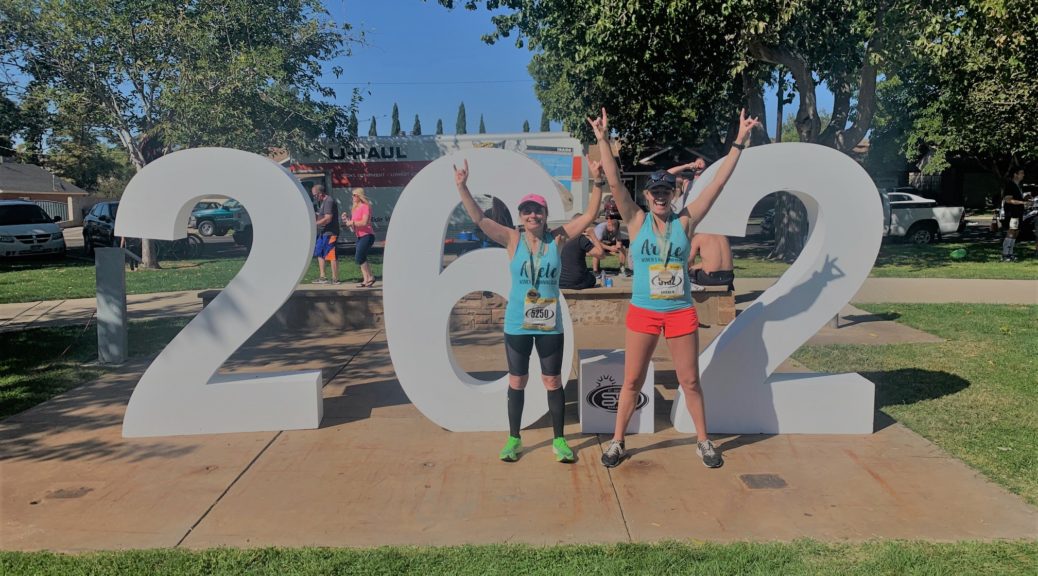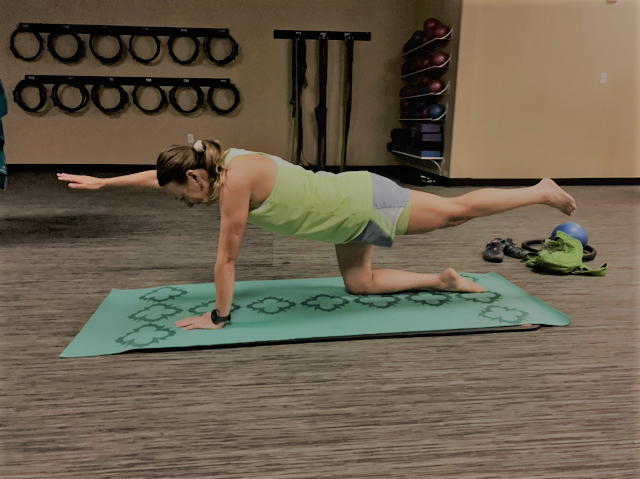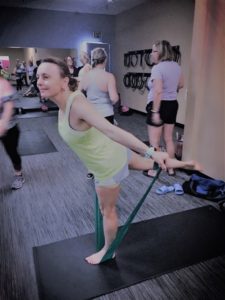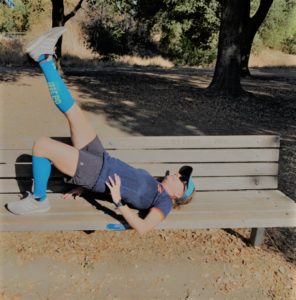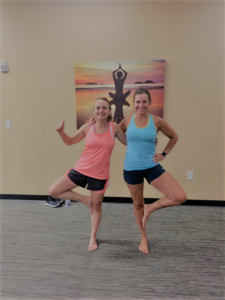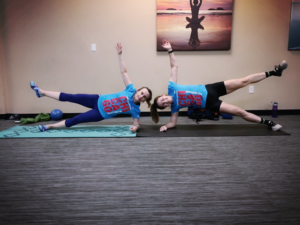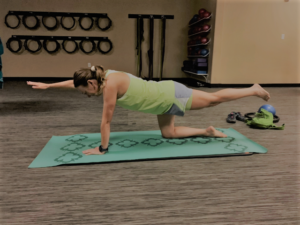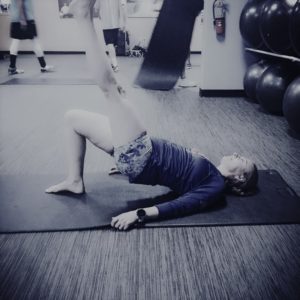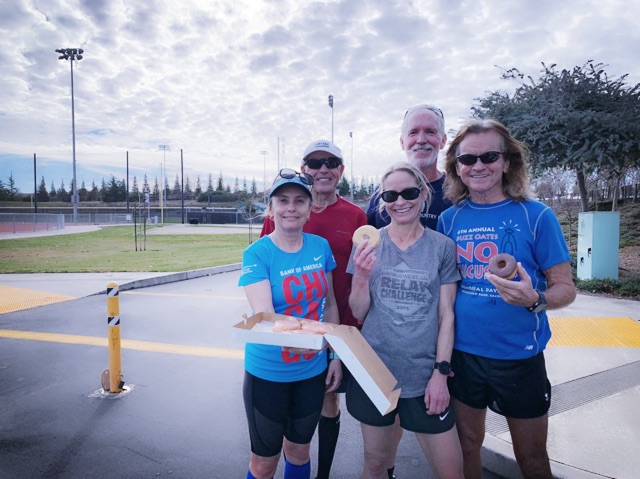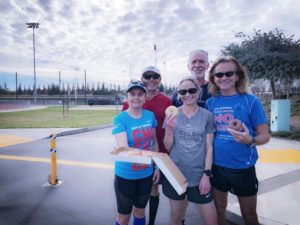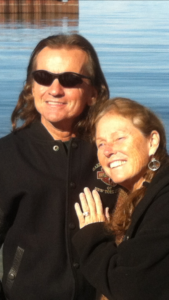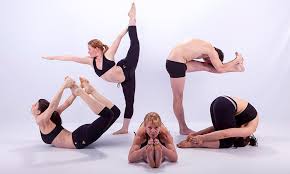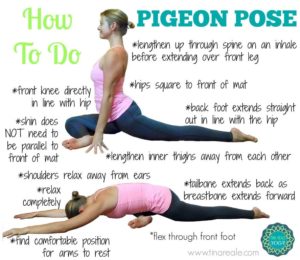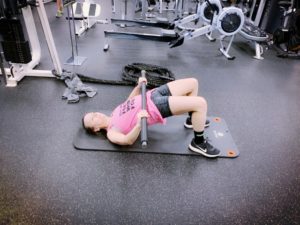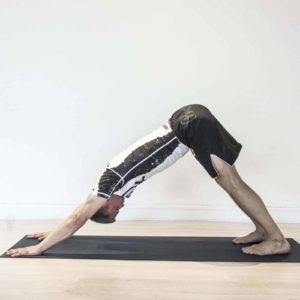“Nothing is good or bad, but thinking makes it so.” William Shakespeare
Going into St. George marathon, which was my 10th, I decided that I would not let the hills bother me in any way, or consider them good or bad, since I agree with Shakespeare that it is our mere thinking that makes something good or bad. Instead, I decided to train with purpose and focus on conquering the hills, especially because I had had the opportunity to run 19 miles on the course this summer during our trip to Utah. My long run that summer day in August did not go very well. The hills were long and ubiquitous both up and down, taxing my glutes and calf muscles. My legs felt as heavy as the beautiful red rocks surrounding me on the course and my pace was slower than usual.
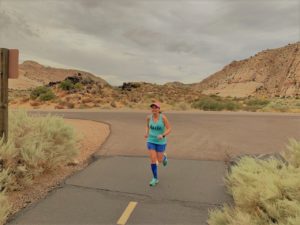
Needless to say, I freaked out and thought there was no way I would run strong on the course that everybody called downhill and fast, so together with my awesome friend and coach Jenny Hitchings, we devised a great training schedule that included hills and tough speed workouts. Additionally, every time I had an easy and recovery 10-mile runs on my schedule, I would try to run trails for some more hills and elevation.
St. George Marathon highlights and Course Analysis
It was the day before the marathon and many runners from 20 countries and 49 states were stirring…
My friend and Arete team mate Briana Telford and I shared a house that I had rented through VRBO and we did everything right before our marathon. I cooked spaghetti and sweet potatoes fries for dinner, we hydrated, conserved our energy, and went to bed around 9:30 the night before the marathon, since we got up before 4 a.m. to catch the bus taking us to the start line.
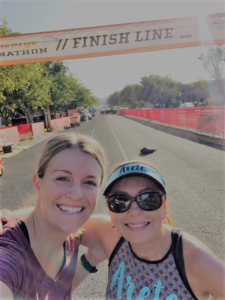
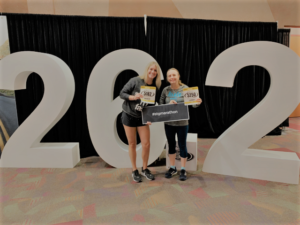
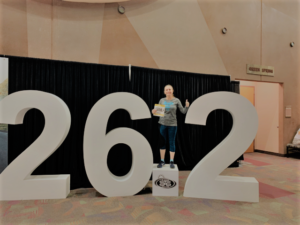
The start line and the first 7 miles of downhill smiles
The house we stayed at was less than a mile away from the finish line and from where we had to take the bus that took us to the start line up in the Pine Valley mountains at 5,240 feet elevation. Briana and I walked to Worthen Park and got on the bus with no wait. Once we arrived at the start line, the volunteers gave us space blankets. The temperature was 35 degrees and a little windy, so we immediately huddled around the fire together with other runners.
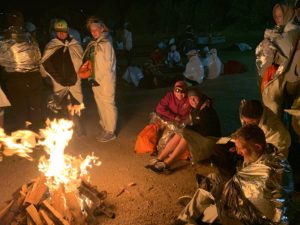
Watching the fire was a magical and unique experience at the start of the marathon, which was a first for both of us. The flames twisted, danced, and glowed in the morning cool air. Our legs and feet got warmer – almost a burning sensation; our bodies and souls ablaze with marathon flames that simply called our names. As we got close to the start time, which was 6:45 a.m., we finally left the fire, shed our warm jackets and sent our bags on the truck that took all our belongings to the finish line. We barely delivered our bags, when they announced that there was one minute left before the start.
Before I knew it, I started running in the dark surrounded by the cold morning Utah air and the breathing of many runners. My breathing was smooth. I ran through the darkness and could not see anything on my watch. I ran by feel telling myself not to go off too fast. My first mile was 7:48 and then I kept running by feel till the 5K, being on track. The next four miles were in the 7:20 and 7:30 pace, as the downhill was steep and I thought it was worse to put the brakes. I caught up with the 3:25 pacers and they were chatting away, talking about the one-mile long hill coming up at Veyo, a small little town with one gas station.
Miles 7-12- Let the hills begin
It is very easy to think that St George marathon is just a downhill race, as runners descend nearly 2,600 feet through scenic Southwest Utah, but unfortunately, maps don’t do justice to a course. At mile 7, I knew I had to climb for exactly one mile, so I was ready and took the hill steadily, trying to conserve energy. The hills continued till mile 12, even though there were some downhills in between, but not enough to keep me at my desired 7:50 pace. I relaxed and did not panic, as I knew this portion of the course very well. The hills did not feel very difficult, but they did slow me down. I was looking forward to taking off after these miles, thinking that it was mainly downhill, but my body had different plans.
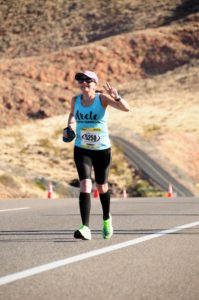
Miles 13 to 19 – Up and Down I Ran
I was really planning on taking off and hitting my GMP (gross marathon pace) again, but my hips were a little tight and I couldn’t quite push, so I was happy to run in the low 8s and some mid 8s. To my surprise, my calf muscles were not sore or tight and my glutes were also pretty good. I had taped both my calves using the wide KT tape and it seemed to work. As I kept losing my desired pace, I did not feel despair like I felt earlier this year running the Boston marathon. On the contrary, I was running with joy and gratitude, relishing the white, pink, and red sandstone rocks. I was keeping a steady pace and the spectators were wonderful, cheering on me and saying “Go Carmen,” as we all had our names typed on our bibs. I kept looking at my watch to see how far off I was from my goal of breaking 3:30 and I realized that I needed to shift my focus on my form, as my knees were starting to hurt from all the descending, as well as try to make this my second fastest marathon.
Miles 20 to the Finish line
The climbing up and down the hills does not end till about mile 19, when the course descends into town, where there is a flat and fast 10k for those runners who can push it. Even though I could feel my body getting tired, I started to pick up my pace and ran faster in this portion. I had promised my friend and Arete team mate Christina Nokes that I would run as fast as I could for her at the end and that I would chant our new marathon mantra: “Like a savage.” As I ran faster and stronger through town, I kept lifting my arms and was shouting “like a savage.” One of the spectators said cheerfully: “Yeah, you are a savage. ” Many spectators were amused and cheered even louder for me, which helped me run faster and with more joy. With two miles left, the spectators were handing out popsicles and I truly enjoyed mine, while running faster and stronger towards the finish line, which was electrifying, as there were rows of spectators on both sides. I had finished my 10th marathon as my third fastest marathon in 3:41:46, qualifying again to run Boston marathon, which I had promised myself not to run again till I am 70 when I will try to win my age group.
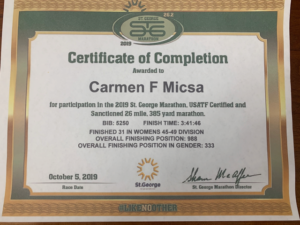
My amazing friend and Arete team mate Briana was at the finish line cheering for me and taking this video of me right as I crossed the finish. Video_Finishline_StGeorge
To my great joy, Briana PRed by about 5 minutes and finished in 3:24:25. We were both happy to complete a tough, but great marathon.

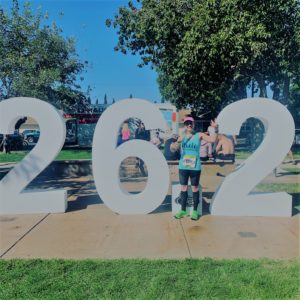
With St. George being considered one of the top 10 qualifiers for the Boston marathon, according to the marathon website, here are my recommendations to everyone wanting to run this course strong and qualify for Boston, or achieve a personal best time.
Training Tips for a Successful St. George, Boston, New York, or any hilly marathon
- Practice running both uphill and downhill. My hill workouts included running steady uphill and controlled downhill, but I sometimes made the workout harder by running hard downhill at 7 minute pace to shred the quads and get them stronger for this marathon, which is not for the runners who hate the hills. The hill workouts that my awesome coach Jenny Hitchings gave me also included doing three miles at marathon pace after my hill repeats and sometimes doing a tempo right before the hill repeats. These specific workouts kept my quads pretty strong till the last two miles of the marathon.
- Use the recovery day and easy runs to run on the trails, as the hills there are ubiquitous and you will train at higher elevation. Whenever I had 10 miles recovery on my schedule the day after speed workout, I tried to hit the trials and run super easy, but practice on the hills, which is quite helpful for a hilly marathon.
- In the building phase of the marathon, feel free to do your long runs on the trails so that you can get your climbing legs in good shape.
- For the most advanced runners who feel comfortable on the trails and who are not injury prone, although we can all get injured at any time, I would recommend doing a hilly, but not super technical 50K race about 5 to 8 weeks out before the marathon, as I have done that before another downhill marathon last year at Mountains to Beach and I felt the strongest out of all my marathons, but that doesn’t mean it will always work.
- Speed workout on the hills doing 5 to 8 x800 meters on a fairly steep downhill and running back up. Try to do this workout once or twice a month, as the purpose is to beat up the quads to get them strong for the hilly course. Run hard, but controlled downhill with a good form and turnover, after which rest for 2 minutes at the bottom and then climb back up strong.
To sum things up, hills are runners’ best friends and we should visit them often for speed and strength.
To search free listings, please go to http://dynamicsacramentohomes.com/
For more info on running and real estate, whether buying or selling, please e-mail me at carmenmicsa@yahoo.com, or call me at 916-342-2446. Running for real estate with joy!

